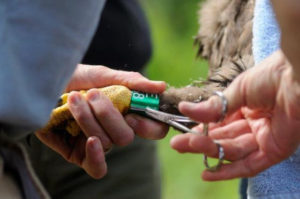Image of an Eagle
Article and photos by Joe Mish
Rose gets a green aluminum band affixed to her left leg and a silver band to her right leg. Green is the band color used by NJ and silver is a federal band. Each state uses a specific color to quickly identify a banded eagle’s origin.
Over last century as the northeast bald eagle population dwindled, their image flourished as a marketing tool to brand high end merchandise. Gilded eagles sat upon flag poles in parades and auditoriums. Dollar bills and quarters bore engraved, lone eagles, wings spread and talons flared, about to attack at the least provocation.
Never did any image show more than one eagle, even though they mate for life and are dedicated parents. As a generation, we came to know eagles as powerful solitary creatures frozen in iconic poses. There was nothing to challenge that image, the skies were empty and no shadows could be seen speeding across the land. Least of all in central NJ, a land reputed to be sanitized of nature.
Awareness of man’s place in the natural world and his impact on the environment began to be studied in universities like Rutgers College of Agriculture and Environmental Science in the late 1960s, which opened the door to a new era of enlightenment and activism. Books like Silent Spring and Sand County Almanac were the seeds sown to nourish the idea humans were not apart from the cascade of life that flowed, uninterrupted, from the soil and water to apex predators, like the eagle and peregrine falcon.
Eagle restoration in NJ began in earnest in the 1980s accompanied by an ever-growing accumulation of study data gleaned by observation and scientific research. Still the view of intimate eagle relationships and social interaction remained at a sky-high level and not well published for public consumption.
Eagles kept their privacy and legacy reputation as solitary creatures intact until the advent of live cameras, genetic mapping, banding and miniature transmitters.
As far as the public is concerned, it is the live cams, set above some nests and broadcast on the internet, that provide non-stop coverage of eagle antics in the aerie to feed an insatiable voyeuristic human appetite.
The forums that accompany these spy cams generate lively conversation and together, have created a whole new audience beyond those immersed in all things nature. People who can’t tell a snow goose from a snow bunting, are now addicted a wildlife reality show.
And addictive it is, as viewers and scientists both learn what goes on behind nest walls. As voyeurs watch, they see behaviors that mimic human responses. The eagle screaming at its partner could very well be a replay of last night’s argument with their spouse, “who never listens to a word I say”.
Cumulatively, what we see are personality differences among pairs of eagles, where before we had only anecdotal observations and generalized conclusions. We knew the eagle as a solitary warrior and now we see a great raptor dedicated to its mate and offspring. When we look closely into the world of an eagle we see a glimpse of ourselves.
Locally the intrigue has been riveting, with a ringside seat to a female ingénue coming between a mated pair, a harassing hawk obliterated by an annoyed eagle and tender moments of dedicated parents doting on their precious offspring.
We watch as courting behavior evolves into mating, egg laying and alternate job sharing, as pairs relieve each other from brooding duty. We see and hear the wailing of one parent when their mate fails to return, either through injury or death. You cannot be unaffected by that sight and sound as what you experience is automatically translated into human terms.
A live cam from another state showed a female eagle covering her three, day old chicks, as a late spring snowstorm raged. That moment was tender enough but then the male positioned himself alongside the female, resting his head on her shoulder and spread his wings to shield his mate and their chicks from the heavy snowfall; our collective tears flowed.
Recently an eagle that prematurely fell from a local nest was rescued, examined and found to be in good health. Given that one parent went missing in the weeks prior to the fall and it was impossible to return the bird to the nest, a decision was made to place that eagle in another nearby nest.
Armed with the knowledge of intimate eagle behavior and demonstrated dedication to their young, fostering that young eagle was done with full confidence it would be accepted and thrive.
Only time will tell but so far, so good. Years hence, if you see a bald eagle bearing a green leg band, engraved with E68, you now know the rest of the story. Consider an eagle that was killed, June 2015, in upstate NY by a car, was banded 38 years prior! So, eagle E68, affectionately named, Rose, and her foster siblings, E66 and E67 have a good chance to be seen by your grandchildren!
Author Joe Mish has been running wild in New Jersey since childhood when he found ways to escape his mother’s watchful eyes. He continues to trek the swamps, rivers and thickets seeking to share, with the residents and visitors, all of the state’s natural beauty hidden within full view. To read more of his writing and view more of his gorgeous photographs visit Winter Bear Rising, his wordpress blog. Joe’s series “Nature on the Raritan, Hidden in Plain View” runs monthly as part of the LRWP “Voices of the Watershed” series. Writing and photos used with permission from the author.

